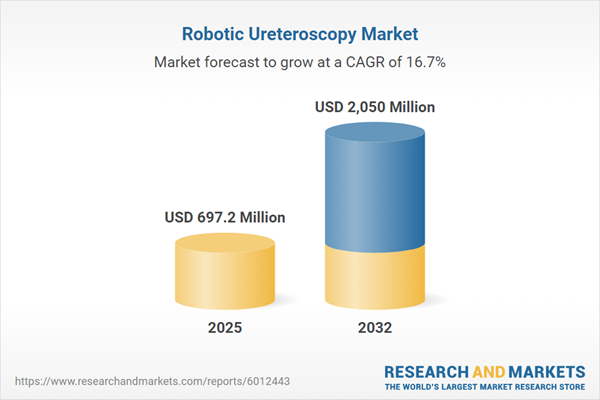Speak directly to the analyst to clarify any post sales queries you may have.
The robotic ureteroscopy market is evolving rapidly, driven by a surge in healthcare providers seeking minimally invasive solutions and improved operational efficiency for urological care. Senior decision-makers now require strategic insights on technology adoption, market segmentation, and procurement planning to stay competitive.
Market Snapshot: Growth Trajectory in Robotic Ureteroscopy
Between 2024 and 2025, the robotic ureteroscopy market advanced from USD 598.93 million to USD 697.20 million, demonstrating a compound annual growth rate of 16.69%. This expansion is fueled by preferences for minimally invasive surgical techniques and continuous improvement in imaging and automation. As patient safety and streamlined workflows become critical, the industry is prioritizing integration of advanced systems that align with modern clinical protocols. The momentum highlights a significant shift toward coordinated, technology-driven surgical environments in both established and emerging healthcare settings.
Scope & Segmentation of the Robotic Ureteroscopy Market
This report provides senior executives with a thorough overview of the robotic ureteroscopy market’s segmentation across product innovation, technology platforms, end-user environments, applications, and geographic trends. The analysis supports precise decision-making around procurement, strategic investments, and competitive positioning. By clarifying operational drivers, the scope enables tailored evaluation of current vendor offerings:
- Product Types: Single-use, multi-use flexible, and semi-rigid ureteroscopes give institutions versatility to match devices with procedural protocols and evolving clinical requirements.
- Reusable Versus Disposable Devices: Disposable solutions are engineered for infection control, whereas reusable devices depend on stringent sterilization standards to protect patient wellbeing.
- Technology: Advances include active robotic platforms featuring electric or pneumatic controllers, and semi-active systems that blend automation with manual precision for improved operator oversight.
- End Users: Primary users include ambulatory clinics, hospitals, surgical centers, and research organizations, each with distinct needs for workflow optimization and seamless integration.
- Applications: Robotic ureteroscopy supports diagnostic and therapeutic interventions such as imaging, biopsy, laser lithotripsy, stent placement, stone removal, and tumor ablation.
- Regional Coverage: The report reviews market dynamics in North America, South America, Europe, Asia-Pacific, and the Middle East & Africa, considering the impact of local regulations, manufacturing capacity, and tailored entry strategies.
- Companies Analyzed: Competitive benchmarking assesses leading participants like Intuitive Surgical, Auris Health, XACT Robotics, Anzu Medical, and ELMED S.A., informing partnership strategies and commercial planning.
Key Takeaways for Senior Decision-Makers
- Expansion of robotic ureteroscopy is broadening the spectrum of treatable urological conditions, enhancing healthcare providers’ ability to offer both routine and complex procedures.
- Upgraded user interfaces and digital workflow systems are increasing procedural consistency and throughput, reducing variability in performance across institutions.
- Adoption of single-use and hybrid devices is strengthening infection control policies and supporting organizational goals for patient safety and sterility.
- Strengthened regional manufacturing and technical partnerships enable device customization and smoother adaptation to local regulatory environments, facilitating cross-market deployment.
- Data-driven training and onboarding support efficient system uptake, minimizing disruptions and promoting clinician confidence during transitions to robotic platforms.
- Flexible reimbursement structures play a growing role in budget planning, empowering organizations to respond nimbly to shifting financial constraints and opportunities.
Tariff Impact: Navigating Cost and Supply Chain Shift
Recent U.S. tariffs on precision motors and fiber-optic components have prompted healthcare providers to reconsider global sourcing and invest in regional assembly models. Increased focus on alternative materials and new strategic partnerships is strengthening supply chain continuity, enhancing compliance with regulatory requirements, and preserving access to key robotic ureteroscopy system components.
Methodology & Data Sources
Insights in this report are grounded in interviews with urology specialists, device procurement managers, and engineering professionals. Conclusions are validated through review of clinical trial outcomes, regulatory and patent information, and independent expert panels, ensuring a comprehensive and reliable foundation for executive decision-making.
Why This Report Matters
- Enables executive teams to align strategic planning and procurement with the latest advances in robotic ureteroscopy and clinical automation.
- Equips organizations to navigate reimbursement complexity and enhance supply chain resilience amid dynamic market and regulatory environments.
- Consolidates operational, regulatory, and competitive intelligence to strengthen strategic planning and benchmark performance against industry leaders.
Conclusion
The report delivers actionable insights for senior leaders, offering the clarity needed to prepare for the next stage of robotic ureteroscopy market development and optimize investments in emerging urological care technologies.
Additional Product Information:
- Purchase of this report includes 1 year online access with quarterly updates.
- This report can be updated on request. Please contact our Customer Experience team using the Ask a Question widget on our website.
Table of Contents
3. Executive Summary
4. Market Overview
7. Cumulative Impact of Artificial Intelligence 2025
Companies Mentioned
The companies profiled in this Robotic Ureteroscopy market report include:- Intuitive Surgical, Inc.
- Auris Health, Inc.
- XACT Robotics, Inc.
- Anzu Medical, Inc.
- ELMED S.A.
Table Information
| Report Attribute | Details |
|---|---|
| No. of Pages | 199 |
| Published | October 2025 |
| Forecast Period | 2025 - 2032 |
| Estimated Market Value ( USD | $ 697.2 Million |
| Forecasted Market Value ( USD | $ 2050 Million |
| Compound Annual Growth Rate | 16.6% |
| Regions Covered | Global |
| No. of Companies Mentioned | 6 |









